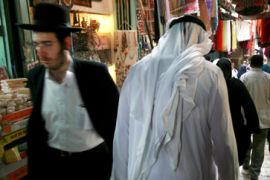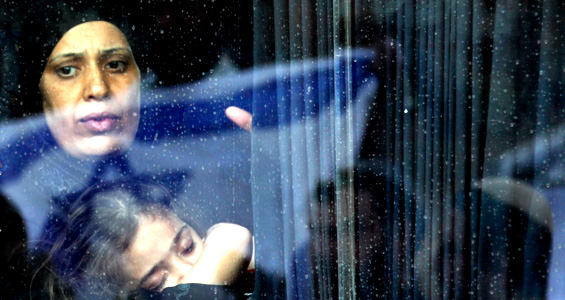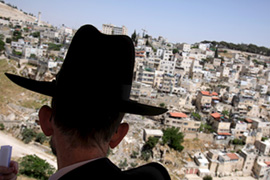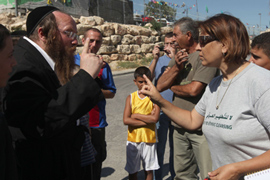Jerusalem’s myriad divisions
Can Palestinians and Israelis ever agree a deal on the sovereignty of the Holy City?

 |
| Palestinians say Israeli settlement growth in Jerusalem erases the Arab identity of the city [EPA] |
Barack Obama, the US president, is attempting to seal an Arab-Israeli peace deal that has eluded the region for more than six decades.
Ahead of an initiative expected to be announced in September, however, Obama will have to mediate how to bring the controversial issue of Jerusalem to the negotiating table. The city is claimed as the capital by both Arabs and Israelis.
Binyamin Netanyahu, Israel’s prime minister, has said that his government is unwilling to negotiate on the status of Jerusalem as a joint Israel-Palestinian capital.
Historian Mark Levine looks at the divisive issues that Jerusalem evokes and whether Arabs and Israelis can ever agree to share the city between them.
There are at least four major obstacles to achieving a lasting peace agreement between Israelis and Palestinians: settlements, refugees, economic independence, and, of course, Jerusalem.
Each component presents its own difficulties, but Jerusalem remains even more stubborn than the rest because it holds an ideological power on Israeli and Palestinian identities.
This is aggravated by the reality that most of the other major issues in the negotiating process compound the difficulties in reaching a workable solution to who controls the city and its environs.
| Planning for Peace | ||||
|
|
That Jerusalem is perhaps the most thorny issue of the peace process – the argument over sovereignty of its most important holy sites helped doom the Camp David negotiations in July 2000 – should come as no surprise.
The city has been at the centre of religious and political struggles for as many as 4,000 years.
Jerusalem was conquered several times in the biblical period, after which Israelites regained control, culminating in the Roman conquest of 63 BC. The Romans controlled the city during the time of Jesus Christ, who was crucified outside the city’s gates.
Jews were largely prevented from entering Jerusalem during the remainder of the Roman, and after that, Christian Byzantine eras, and returned in significant numbers only after the Muslim conquest in 638.
Jerusalem is also central to Muslim theology, as it was the first qibla, or direction of worship, for Muslims, and the site of the Second Temple is believed to be where the Prophet Muhammad made his “night journey” to Heaven.
The “al-Aqsa Mosque” takes its name from the Quranic sura, or verse (17:1) where God “carried his servant by night from the Sacred Mosque (Mecca) to the Farthest Mosque (Jerusalem)”.
Crusaders, Mamlukes and Ottomans
Jerusalem changed hands several times in the ensuing centuries – Crusaders, Mamlukes and Ottomans all controlled the city for various periods of time.
In the late Ottoman period Jerusalem underwent a significant period of growth as Jews, Muslims and Christians, and increasing numbers of European pilgrims, bought land and built neighbourhoods outside the Old City.
|
“The division of Jerusalem in 1948, with Jordan controlling the Old City and the Western Wall, saw the creation of “eastern” and “western” halves of the city which were essentially cleansed of the other community” |
Indeed, the current division of Jerusalem into Jewish-Western and Palestinian-Eastern halves – which is, in fact, no longer accurate given the large Jewish settler population in East Jerusalem – belies the much more mixed ethnic and religious landscape of the city before 1948.
It is worth noting that when Zionism first arrived in Palestine, Jerusalem was not the primary focus of activity.
Early, secular, Zionist settlers were more ideologically concerned with “making the desert bloom” – creating new intensive settlements in the hinterland that would be the home of the “new Jews” who came to “rebuild” their ancient homeland – rather than an ancient, traditional and religiously-oriented Jerusalem.
Throughout the British Mandate period, it was Jaffa and Tel Aviv – “the New Israel” – that were the competing economic and cultural centres of Palestinian and Jewish Palestine.
Zionism was a secular political ideology, but it was, from the start, both ethnically and religiously exclusive – Jews as both a people (or nation) and members of the same faith were believed to have a unique right to Palestine.
Theodor Herzl might have depicted Palestinians as committed Zionists in his novel Tel Aviv (the name for the capital of his imagined, modern Palestine), but the reality was that from the beginning of Zionist colonisation, ethnic and religious divisions ensured increasing conflict between Jews and Palestinian Arabs.
This was felt not just in agricultural settlements or the Jaffa-Tel Aviv region – where the first large-scale inter-communal violence erupted in 1921 – but in Jerusalem as well.
Competition for land
An attempt by Jewish worshippers to change religious protocol at the Western or Wailing Wall was the spark for the “riots” of 1929. The underlying cause for the conflict was, however, the increasing competition for land between the burgeoning Zionist population and Palestinian peasants.
Nationalism, religion and territory had become inextricably joined by the 1920s, remaining so until this day. And Jerusalem became the symbol of the larger conflict, particularly after the city’s division in 1948.
 |
| Israeli settlers have moved into areas to change the demographic balance [EPA] |
The division of Jerusalem in 1948, with Jordan controlling the Old City and the Western Wall, saw the creation of “eastern” and “western” halves of the city which were essentially cleansed of the other community.
Dozens of Palestinian satellite villages in what become Israel were destroyed after the war, and upward of 80,000 Palestinians forced to flee. Israeli Jews had no access to Judaism’s holiest site until the conquest of Jerusalem by Israeli forces in 1967.
It was the “reunification” of Jerusalem in 1967 that forced the current dynamics. The stunning recapture of Jerusalem was viewed as a miracle even by the majority of secular Israelis, and helped usher in an era in which religion would play a far more direct role in Israeli identity than it had done in Zionist and Israeli history to that point.
It is almost impossible to imagine the settler movement’s rise and eventual dominance of Israeli politics without the powerful pull, and legitimisation of Israel’s assertion of control and sovereignty over the Jerusalem region, which has become a microcosm of struggles over territory, resources, and demography in the wider conflict during the last 40 years.
Almost immediately after the war Jews began to establish outposts, and later illegal settlements, across the West Bank and particularly in East Jerusalem and its environs, which were placed under Israeli “jurisdiction” soon after the 1967 war, and formally annexed in 1980.
‘Judaisation’ of Jerusalem
By 1977, around 50,000 Israelis had moved into East Jerusalem and the newly erected settlements surrounding it. By 1990, the number of settlers had grown to around 120,000. A decade later the number had climbed to about 170,000.
What Israelis openly describe as the “Judaisation” of Jerusalem is at the core of the settlement strategy for the West Bank more broadly, which has produced a population of approximately 200,000 people living in more than a dozen neighbourhoods, satellite towns and “large settlement blocks” such as Givat Zeev, Gush Etzion and the Maaleh Adumim.
This large region is significant in several ways. Today, roughly 70 per cent of the eastern part of the Jerusalem municipality lies in the city’s eastern, occupied half.
Second, this territory forms the core of a plan to expand metropolitan Jerusalem so it stretches from Ramallah in the north to Hebron in the south, from Jericho in the east to Bet Shemesh in the north west – that is fully 30 per cent of the West Bank.
Finally, the population figure is highly significant, because it means that the Jewish population of East Jerusalem and its environs is now roughly equal, or even greater than the Palestinian population.
Palestinian lands seized
|
“All Israeli governments have declared that Jerusalem will always remain ‘the undivided capital of Israel'” |
This reality has placed huge swaths of formerly Palestinian lands under permanent Israeli control, effectively removing them from the negotiating table during final status talks.
The impact on negotiations has been clear. From the start of Oslo-era negotiations in Madrid, Israel understood the symbolic and political importance of Jerusalem, which is why it initially refused to negotiate with Jerusalem Palestinians as well as with the PLO.
Even during the Oslo era, the government refused to allow any symbols of Palestinian sovereignty in Jerusalem, epitomised by the 2001 closure of the Orient House, which was the de facto Palestinian office in the city.
On the ground, Israeli strategies to ensure permanent control over the Jerusalem region include tactics used in the West Bank and Gaza more broadly since 1967.
Administrative and municipal borders have been changed to place lands under Israeli military or government control. Homes are routinely demolished and agricultural land destroyed because of violations of Israeli administrative regulations.
Jewish settlers have been moved into areas to change the demographic balance.
East Jerusalem has been encircled and Palestinians are forced to carry special permits to enter or live in Jerusalem, which are increasingly being revoked by the government in an effort to further reduce their numbers.
“Separation Wall”
Jerusalem and its settlements are surrounded by a huge section of the “Separation” or “Apartheid” Wall, creating what Israeli authorities have termed the “Jerusalem Envelope”.
The name signals the goal of surrounding and cutting off East Jerusalem, as well as Palestinian neighbourhoods and villages within it, from the rest of the West Bank.
Tens of thousands of dunams (a dunam is equal to 1,000 square metres) of Palestinian land have been expropriated to create the security perimeter in which the wall is built.
The economic damage caused by the isolation of villages from Jerusalem has led to their depopulation, as residents are forced to leave or choose between maintaining a Jerusalem identity and so lose access to the West Bank.
The bypass roads that radiate out from the city across the entire West Bank further isolate Palestinian villages and towns from their agricultural lands.
 |
| Israel says it will build settlements in the Sheikh Jarrah district in East Jerusalem [AFP] |
All told, the Israeli “matrix of control” that is comprised of the settlements, the wall, the roads and the checkpoints, has all but suffocated Palestinian political, social and economic life – particularly through the isolation of Jerusalem from its traditional satellite towns and the other major Palestinian cities, which can only be reached by crossings Israeli checkpoints.
At the opening of the Madrid Conference in 1991, the Palestinian delegation declared that Jerusalem was the “the soul of Palestine” and went on to state that Jerusalem was “the capital of our homeland and future state, defining Palestinian existence, past, present, and future.”
For its part, all Israeli governments have declared that Jerusalem will always remain “the undivided capital of Israel” and that the city is as Jewish as “London is British”.
Behind-the-scenes negotiations during Oslo came close to resolving this impasse, based on a formula in which what is under Jewish/Israeli control will remain Jewish and what is Palestinian will remain Palestinian.
The problem is that the ever-increasing Israeli control over East Jerusalem – most recently epitomised by the much-criticised Israeli announcement that it intends to build in the Palestinian neighbourhood of Sheikh Jarrah, near the Old City – leaves increasingly little land remaining in Palestinian hands.
Even if such an agreement could be reached before East Jerusalem is permanently separated from the West Bank, the core religious issue of who has sovereignty over the Temple Mount will prove extremely difficult to overcome, as long as both link religious and nationalist identities together.
Unless both sides are convinced to think more broadly about Jerusalem as an open city with various zones and levels of sovereignty – some of it shared – there is little chance that a workable agreement can be found on the Jerusalem question.
Mark Levine is a professor of history at the University of California, Irvine and author, most recently, of Heavy Metal Islam: Rock, Resistance, and the Struggle for the Soul of Islam (Random House 2008) and Impossible Peace: Israel/Palestine Since 1989 (Zed Books, 2009).
The views expressed in this article are the author’s own and do not necessarily reflect Al Jazeera’s editorial policy.

 Video: The settlements issue
Video: The settlements issue